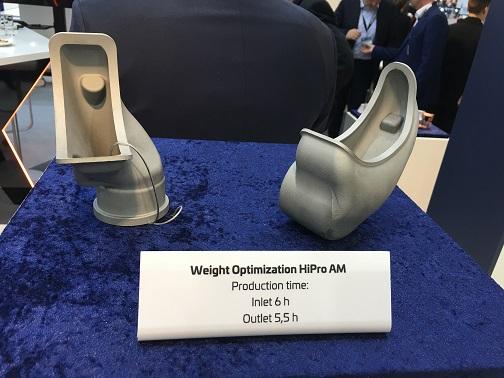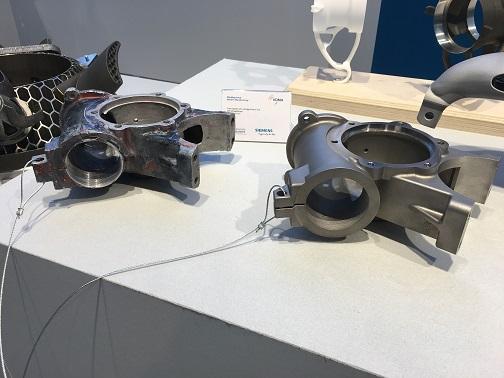Editor-in-Chief
- FMA
- The Fabricator
- FABTECH
- Canadian Metalworking
Our Publications
Categories
- Additive Manufacturing
- Aluminum Welding
- Arc Welding
- Assembly and Joining
- Automation and Robotics
- Bending and Forming
- Consumables
- Cutting and Weld Prep
- Electric Vehicles
- En Español
- Finishing
- Hydroforming
- Laser Cutting
- Laser Welding
- Machining
- Manufacturing Software
- Materials Handling
- Metals/Materials
- Oxyfuel Cutting
- Plasma Cutting
- Power Tools
- Punching and Other Holemaking
- Roll Forming
- Safety
- Sawing
- Shearing
- Shop Management
- Testing and Measuring
- Tube and Pipe Fabrication
- Tube and Pipe Production
- Waterjet Cutting
Industry Directory
Webcasts
Podcasts
FAB 40
Advertise
Subscribe
Account Login
Search
Formnext 2018 recap: Additive manufacturing moves beyond aerospace
Manufacturers in automotive and transportation find value in 3D-printed parts
- By Dan Davis
- November 26, 2018
- Article
- Additive Manufacturing

This entire car chassis from Divergent3D was 3D-printed. It made its public debut in the SLM Solutions booth at Formnext 2018 in Frankfurt, Germany, Nov. 13-16.
If you have any working knowledge of additive manufacturing (AM), you are probably familiar with the GE’s 3D-printed nozzles for its Leap jet engine platform. The business press has been covering this story since 2012 because it really was the first well-publicized case of AM playing a part in a real-world production environment.
The one-piece fuel nozzle replaced an assembly that used to comprise 20 parts. It also had to be of a robust design, as it is exposed to temperatures as high as 2,400 degrees F inside the jet engine. The part was certified for flight in 2016.
Today GE Aviation reportedly has more than 16,000 commitments for its Leap engines. With the demand strong, the company reported that it printed its 30,000th 3D-printed fuel nozzle in the fall of 2018. GE Aviation produces the parts in Auburn, Ala., where it operates more than 40 metal 3D printers for the purpose of part production. GE Aviation reports that each Leap engine has 19 3D-printed fuel nozzles.
GE officials might get tired of talking about the fuel nozzle, but it paved the way for the company’s AM successes. In fact, all new engine design meetings actually begin with discussions about how AM can be incorporated into the product development effort. For example, the new GE 9X engine, which is currently going through certification, has 28 fuel nozzles and combustion mixers that are 3D-printed. In another example, GE Aviation is redesigning the turbo prop engine, which has had virtually the same design for about 50 years, and it will have 12 3D-printed parts, which is helping to reduce the engine weight by 5 percent.
“What we have been doing over the past couple of years is learning to make really large additive manufactured parts,” said Eric Gatlin, GE Aviation’s AM team leader, talking to a crowd gathered at his company’s booth at Formnext 2018 in Frankfurt, Germany, in early November.
Gatlin went on to call the acceptance of AM a “paradigm shift” for GE Aviation. His company is not alone, however. Formnext exhibitors noted that this year’s event was filled with more manufacturers—original equipment manufacturers and Tier 1 suppliers—than they had seen at previous events. (Trade show officials reported that 26,919 people attended the event, a 25 percent increase over Formnext 2017.) Whereas aerospace manufacturers have led the push to make AM a production reality on the shop floor, automotive and transportation companies are looking at the technology in a much more serious manner.
Making It in Automotive
During a Formnext press conference, Paul Heiden, senior vice president, Ultimaker, shared details of how Ford is using the company’s 3D printers at its Cologne, Germany, factory to create production tools for the Ford Focus. He said the company saves about 1,000 euros per printed tool when compared to purchasing the same tool from an outside vendor.
If manufacturing engineers are faced with the need for a tool, they can load the design for it into 3D CAD modeling software, touch up the design, send it to the printer, and print it in a few hours. Heiden said advances in the software, such as incorporating more material types, have helped to make the design tools much easier, so that even the “untrained” can work their way through the software.
With Ford being able to prove out the usefulness of the 3D-printed tools and fixtures, Heiden said the next step is for the company to tackle the spare part inventory; instead of warehousing hundreds of parts, 3D printers will be used to print them as they are ordered. From there, Ford is expected to see what type of impact the technology can make in terms of production parts.
Other automotive companies are already incorporating 3D-printed tools in imaginative ways. Ultimaker had examples of tools that Volkswagen uses at its facilty in Palmela, Portugal:

This tool, produced on an Ultimaker 3D printer, is used to guide bolt placement during wheel placement at a Volkswagen assembly plant in Portugal.
- A liftgate badge that ensures correct positioning of the model emblems on the rear of the car
- A gap measuring tool that is used to check the gaps between parts of the car are within acceptable limit
- A seat spacer that keeps the front seats the right width apart while other parts are being installed in the car interior
- A bolt locator that ensures they are correctly and efficiently places in the wheels
Others are thinking much larger when it comes to redefining automotive manufacturing. Kevin Czinger of Divergent3D is one of them.
Czinger wants to rethink the way that vehicles are manufactured. He wants to create a new approach using advanced computer modeling and AM to create a chassis that is significantly lighter than traditional frames, comprises fewer parts, delivers higher performance, and is less expensive to produce. Divergent3D showcased its 3D-printed chassis in the SLM Solutions Group AG booth at Formnext.
The chassis, printed on SLM 500 machines, is made up of self-fixturing nodes that all fit together when printing is complete. Divergent3D officials suggest that this approach to chassis design and assembly could lead to a $250 million savings in the elimination of tooling costs and a 75 percent reduction in parts.
The company hopes to sell this type of manufacturing cell to automakers in the future. Divergent3D and SLM are linked in a close strategic partnership to make this happen.
Other Transportation Applications
Senior Flexonics is not a company that is well-known to the general public, but it’s a major supplier of parts and assemblies to companies in the vehicle, diesel, medical, oil and gas, and power-generation industries. Representatives of the company met with GKN Powder Metallurgy last year to discuss 3D printing possibilities, and the parties shared their success story at Formnext 2018.
The parts that were redesigned to take advantage of AM were inlet and outlet valves for an exhaust gas recirculation cooler for commercial truck applications, both for on-highway trucking and off-highway construction vehicles. Senior Flexonics was interested in learning to see if there was a more efficient way to create the prototypes that could stand up to real-world testing and possibly serial production. Through its knowledge of producing parts for automotive and industrial applications over the years, GKN had depth of understanding about functional porosity of metal parts.
The latter was important because many engineers assume that parts for certain industrial vehicle applications require 99 percent density. In many of these applications, that’s just not the case, according to Adrian Keppler, CEO at EOS, the machine technology provider and partner in proving out this application.
After development and testing of parts made from EOS StainlessSteel 316L VPro material, Senior Flexonics found AM parts that met its performance goals and could be created much more quickly than its casted counterparts. For instance the inlet could be 3D printed in 70 percent less time when compared to the casting process. During a press conference, all parties involved with the project admitted that this held great potential for serial production down the road.
“You have to rethink the way parts are manufactured,” Keppler said. “You have to see manufacturing in a different way. These are not castings or forgings.”
Focus on High-volume Production
The Holy Grail for many in the AM industry is to see widespread adoption of the technology in high-volume manufacturing environments. That will represent total acceptance in the eyes of many.

AM technology was used to produce these inlet and outlet valves for an exhaust gas recirculation cooler for commercial truck applications. Senior Flexonics, the maker of these prototype parts, is investigating 3D printing for other uses within its company.
With that in mind, material, software, and machine developers are working hard to deliver the goods that can make that happen. Material makers are looking to create powders and plastics that can meet performance expectations in a repeated fashion. Software developers are trying to grow their material databases to make simulation much more realistic. Machine manufacturers are designing units that operate faster and come with larger production envelopes to host more parts at one time. Work remains to be done, but people are energized about the future of AM in the real world of manufacturing.
“I’ve been in the industry for 20 years and during that time, I kept hearing, ‘We’re close to getting the technology in production settings.’ So we waited and waited,” said Paul Bates, general manager, UL Additive Manufacturing Competency Center, and president, Additive Manufacturing Users Group. “But I think we’ve finally reached the point where all of the factors are converging and it’s happening.”
About the Author

Dan Davis
2135 Point Blvd.
Elgin, IL 60123
815-227-8281
Dan Davis is editor-in-chief of The Fabricator, the industry's most widely circulated metal fabricating magazine, and its sister publications, The Tube & Pipe Journal and The Welder. He has been with the publications since April 2002.
About the Publication
- Podcasting
- Podcast:
- The Fabricator Podcast
- Published:
- 04/16/2024
- Running Time:
- 63:29
In this episode of The Fabricator Podcast, Caleb Chamberlain, co-founder and CEO of OSH Cut, discusses his company’s...
- Trending Articles
- Industry Events
16th Annual Safety Conference
- April 30 - May 1, 2024
- Elgin,
Pipe and Tube Conference
- May 21 - 22, 2024
- Omaha, NE
World-Class Roll Forming Workshop
- June 5 - 6, 2024
- Louisville, KY
Advanced Laser Application Workshop
- June 25 - 27, 2024
- Novi, MI



























